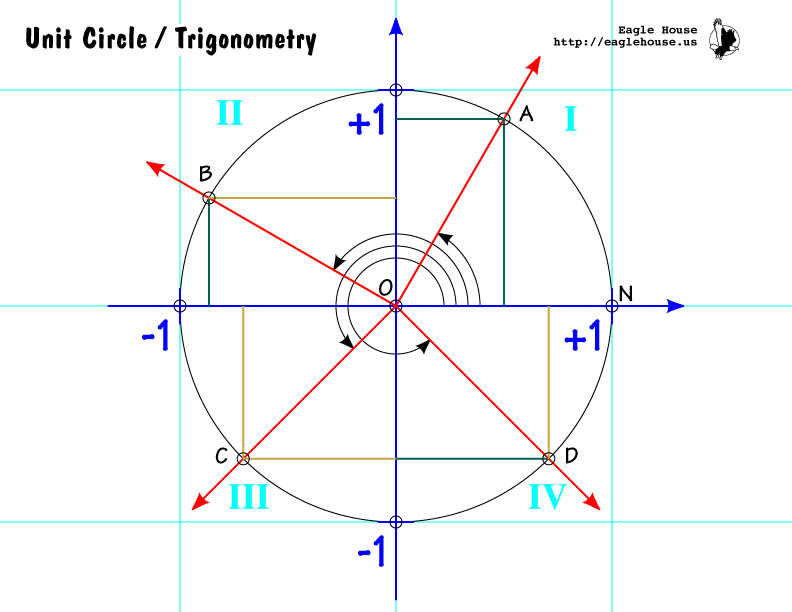Trigonometry
Eagle House = 408/449-9039
Literally, Trigonometry is that branch of Geometry dealing with triangle measurement. There are actually many ways to measure triangles; "trig" consists of a set of special relationships among angles and sides of right triangles. These permit the rapid calculation of unknown dimensions. While the topic appears limited, trig crops up unexpectedly in so many areas of diverse disciplines that study is considered essential.
As with most geometric topics, trig can be explored traditionally, using synthetic methods; or analytically, in which direction most modern texts turn. You may wish to explore in both directions.
Contents |
Basic Facts
In a sense, there is only one trigonometric relationship. Each trig function relates an angle to some ratio of lengths or distances; when one is known, all are known. For convenience, though, several functions are defined. Each function may be derived entirely from any other.
Trig functions are unary operators, as is the absolute value; as opposed to more familiar binary operators such as addition, multiplication, and exponentiation. Given an angle, each trig function produces a ratio; given a ratio, the inverse function produces an angle.
The most common trig functions are:
| Name | Notation | Name | Notation |
|---|---|---|---|
| Sine | sin θ | Cotangent | cot θ |
| Cosine | cos θ | Secant | sec θ |
| Tangent | tan θ | Cosecant | csc θ |
The first three -- sine, cosine, and tangent -- are the most common and must be memorized.
Synthetic Definitions
By definition, of course, one angle of any right triangle is itself a right angle. So, if one other angle is known, then all three are known (The angles of a triangle sum to a straight line.). Every right triangle containing that one known angle is similar to every other. So, given that angle and any one side, the other two sides may be known as well.
Pythagoras is the key to trig. Given any two sides of a right triangle, the third can be found. We proceed in specific cases to derive values for trig functions.
Analytic Definitions
The major problem with the synthetic approach is that it is based on real triangles; therefore it limited to angles less than right and greater than zero. A minor difficulty is that ratios require two things to be measured and a division performed; in the purely classical view, such ratios are incommensurable with direct measures of length, although they may be used to calculate them.
Analytic geometry opens doors here, as elsewhere, by generalizing concepts and presenting familiar figures against the background of the coordinate plane. We begin by constructing a unit circle, defined as a circle of radius equal to 1 arbitrary unit, centered at (0,0). If the coordinate plane here does not seem familiar at first, it is because we explore only the area immediately adjacent to the origin.
Note that angle BCO is always right. Since the hypotenuse of triangle BCO is always 1, BC/BO is simply BC and that is sin θ. Other trig functions are also easily found on this diagram.
Coordinates for named points:
| Letter | (x,y) |
|---|---|
| O | (0,0) |
| F | (1,0) |
| G | (0,1) |
| B | (cos θ, sin θ) |
| A | (0,sin θ) |
| C | (cos θ,0) |
| E | (1,tan θ) |
| D | (0,tan θ) |
| H | (cot θ,1) |
| J | (cot θ,0) |
As θ increases, point B moves counter-clockwise around the unit circle, approaching G, and sin θ approaches 1. While we cannot have a triangle GOO with three sides, two of them of unit length and one of zero length, we are free to define sin π/2 = 1. Similarly, cos π/2 = 0. Also, we find that as θ decreases to zero, we are able to define sin 0 = 0 and cos 0 = 1.
Angles greater than right
What happens in the case of angles greater than π/2? The analytic approach yields considerable fruit. Consider angle NOB. Its sine, as before, is B's y-coordinate; its cosine, as before, is B's x-coordinate. Classical length cannot be negative but as we extend the coordinate plane into negative regions, coordinates may certainly be negative. Thus, cos NOB < 0.
Similarly, sin NOC < 0 and cos NOC < 0. There is no contradiction. We have successfully extended the trig functions to all angles between 0 and 2π, inclusive.
Let's list the possible values and ranges for sine, cosine, and tangent throughout this domain:
| Angle | Example | sin | cos | tan |
|---|---|---|---|---|
| θ = 0 | sin = 0 | cos = +1 | tan = 0 | |
| 0 < θ < π/2 | NOA | 0 < sin < +1 | 0 < cos < +1 | 0 < tan |
| θ = π/2 | sin = +1 | cos = 0 | ? | |
| π/2 < θ < π | NOB | 0 < sin < +1 | -1 < cos < 0 | tan < 0 |
| θ = π | sin = 0 | cos = -1 | tan = 0 | |
| π < θ < 3π/2 | NOC | -1 < sin < 0 | -1 < cos < 0 | 0 > tan |
| θ = 3π/2 | sin = -1 | cos = 0 | ? | |
| 3π/2 < θ < 2π | NOD | -1 < sin < 0 | 0 < cos < +1 | tan < 0 |
| 2π | sin = 0 | cos = +1 | tan = 0 |
The unit circle has not solved all our problems. Note that sine and cosine are limited everywhere to the range -1 to +1. But the range of tangent is unbounded -- the set of all real numbers. And tan π/2 is undefined; the concept does not make any sense there. The same is true for tan 3π/2, cot 0, cot π, and cot 2π.
The key point to remember is that as θ rotates through the four quadrants, the algebraic signs of the trig functions change, too.
Angles greater than a full circle
As you see, we end up right back where we started. All trig functions have the same value for 2π as they do for 0. Can we have an angle greater than a full circle? Certainly.
Consider a skateboarder who spins on his board through two complete circles in one motion. Indeed, this is called a "720"; the skater has turned through an angle of 720°. A mathematical skater would call that trick a "four pi".
All the trig functions repeat, following the same pattern as they do for angles less than 2π. The easiest way to calculate them is simply to subtract 2π from the given angle.
Unlike, say, quadratic functions, trig functions are periodic. We can see this clearly if we chart them. Let x = θ and y = sin θ (or cos θ or tan θ).
The figure shows 2 complete cycles of the basic trig functions and half of another. There is no end to these periodic functions.
Engineers, who commonly use degrees to measure angles for practical purposes, generally consider the x-axis to be periodic, too, numbering it from 0° to 359° and then back to zero again. For it's clear that in some ways, a 450° angle really is the same as a 90° angle. The particular engineering application determines this choice. We speak of phase, in the sense that the sine and cosine functions are not in phase. But this topic takes us away from trig itself.





